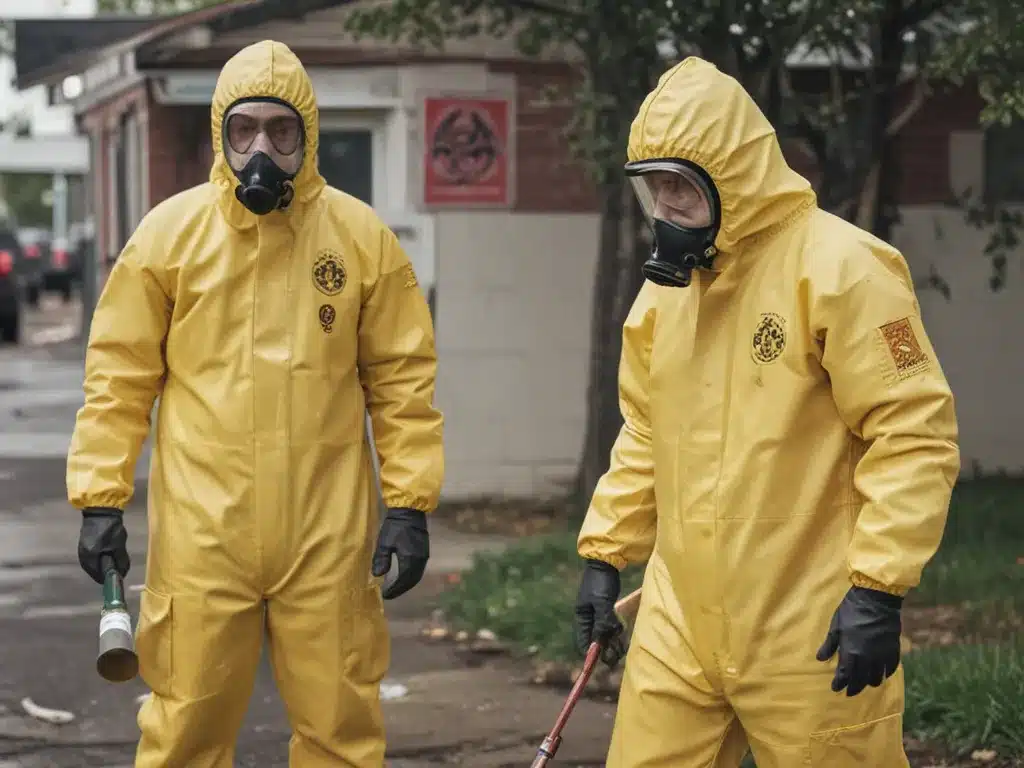Biohazards refer to biological substances that pose a threat to the health of living organisms, primarily humans. Biohazard cleanup and disease prevention are crucial to protect public health and safety. As a certified biohazard cleanup professional, I aim to provide effective biohazard remediation services while minimizing the risk of disease transmission.
Common Biohazards Requiring Professional Cleanup
Some of the most common biohazards I routinely handle during cleanup operations include:
-
Blood spills – Blood can harbor dangerous pathogens like HIV, hepatitis B and C viruses. Proper cleanup and disinfection are vital.
-
Sewage spills – Raw sewage teems with pathogenic bacteria, viruses, protozoa and worms. Improper cleanup can spread serious illnesses.
-
Mold infestations – Mold spores can trigger allergic reactions and respiratory issues. Professional mold remediation is recommended.
-
Death scenes – Unattended deaths may lead to decomposition and pose biohazards. Sensitive handling and disinfection are needed.
-
Needle sticks – Used syringes and needles can transmit HIV, hepatitis and other diseases. Safe disposal protocols must be followed.
-
Animal droppings – Fecal matter from rodents, birds and bats may contain hantavirus, E. coli, salmonella, etc. Proper cleanup is essential.
Personal Protective Equipment
To safely handle biohazardous materials, I wear appropriate personal protective equipment (PPE) including:
-
Hazmat suits – Fluid-resistant whole body suits for blood, sewage and death scene cleanup.
-
Respirators – N95 masks or powered air-purifying respirators to filter airborne particulates.
-
Goggles – Tight-fitting impact goggles to protect eyes against splashes.
-
Gloves – Medical grade nitrile gloves worn under heavier rubber utility gloves.
-
Boot covers – Disposable boot covers to avoid cross-contamination.
-
Head and hair covers – Disposable caps worn under hoods to contain hair.
Proper donning, use, and doffing of PPE is vital to avoid direct contact with hazardous substances.
Cleanup and Disinfection Protocols
My typical cleanup process involves:
- Initial site assessment and hazard analysis
- Isolating and containing the impacted area
- Donning appropriate PPE
- Removing bulk waste (solids, semisolids)
- Applying disinfectants registered by the EPA against bloodborne pathogens
- Rinsing and repeating disinfection as necessary
- Aeration to remove odors and harmful volatile organic compounds
- Disposal of contaminated PPE and cleaning materials
- Post-remediation testing
I use hospital-grade disinfectants containing sodium hypochlorite (bleach) or quaternary ammonium compounds to kill dangerous viruses, bacteria and fungi.
For large-scale remediation projects, I may also use fogging machines to saturate affected areas with disinfecting mists. Air scrubbing units equipped with HEPA filters help remove airborne particulates.
Safe Handling and Disposal of Biohazardous Waste
Proper waste segregation, containment, and disposal prevents the further spread of hazardous substances:
- Biohazardous waste is collected in approved red bags and sharps containers.
- Waste is transported in sealed, leak-proof containers labeled with biohazard symbols.
- Manifests track biohazardous waste from point of generation to final disposal.
- Treatment methods like autoclaving, chemical disinfection, or incineration destroy pathogens.
- Treated waste is disposed of in licensed landfills or medical waste facilities.
Sharps and used needles require special handling to avoid needlestick injuries. They are typically incinerated or disposed in puncture-proof containers.
Preventing Disease Transmission
To minimize disease transmission risk, I advise my clients to:
-
Ventilate affected areas after cleanup to improve air quality.
-
Avoid exposure to contaminants by evacuating impacted rooms temporarily.
-
Clean and disinfect surrounding surfaces like floors, furniture and walls.
-
Wash hands thoroughly with soap and water after entering remediated areas.
-
Launder fabrics like carpets, bedding, and upholstery exposed to contaminants.
-
Dry out moisture-laden materials to discourage mold growth.
Regular building maintenance, prompt spill cleanup, proper hygiene, and pest control also help prevent biohazard incidents and disease outbreaks.
As a certified biohazard cleanup technician, I undergo vaccinations, medical clearances, and rigorous training to perform my duties safely. I keep up with the latest science-based standards, methods, and regulations for effective, ethical biohazard remediation. My goal is to thoroughly clean and restore contaminated environments while safeguarding the health of workers and building occupants.







